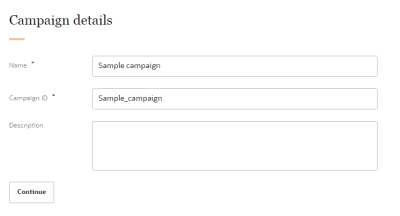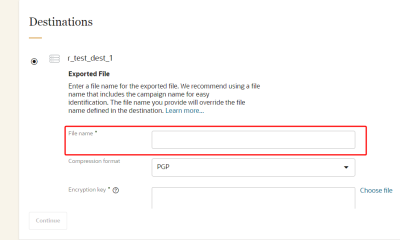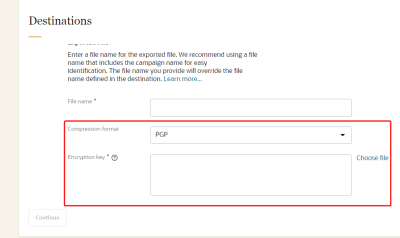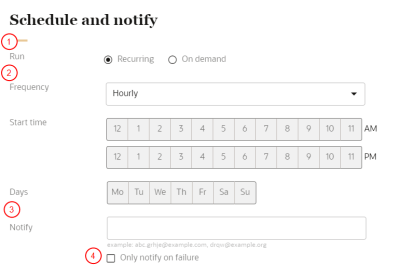Creating segment deliveries
Learn more by watching the video!
When you create a campaign in Oracle Unity, you set up an export of a segment to a marketing orchestration platform such as Oracle Responsys or Oracle Eloqua.
Create a new campaign
To create a new campaign:
-
Click the Oracle icon
 in the bottom-right corner to open the navigation menu.
in the bottom-right corner to open the navigation menu.
- Select Campaigns.
- In the top-right corner, click Create campaign.
The Create campaign page is displayed.
Note: You can open and close the different sections on the page by clicking the Arrow button ![]() , or anywhere else in the section heading.
, or anywhere else in the section heading.
Step 1: Define campaign details
The campaign details section allows you to define how the campaign will display in Oracle Unity.
To define the campaign details:
- Enter the details for the campaign.
- Name: Enter a unique name. The name must be 1 or more characters, up to a maximum of 128. Other than underscores (_) and hyphens (-), special characters are not allowed. The first character cannot be a space. You can use characters from all languages supported in the language settings.
-
Campaign ID: The unique system identifier for your campaign. You can't change this value after you create the campaign.
- If the campaign name uses English characters, the Campaign ID field is auto-populated from the campaign name you enter. You can change this value before the campaign is created.
- If the campaign name uses characters from another language supported in the language settings, the Campaign ID field will be left blank. You will need to enter a name using English characters.
- Description: Enter a description. This field is optional, but it is highly recommended to add descriptions for any entity created. This helps all other users get additional context when using and navigating Oracle Unity. The description can have a maximum of 512 characters with no restrictions on characters used. You can use characters from all languages supported in the language settings.
- Click Continue.
Step 2: Select destination
The Destination section allows you to select where you want to export the segment. Depending on the destination type selected, you will need to follow specific steps:
- To select a Secure FTP destination, refer to the steps below.
- To select an Oracle Responsys destination, refer to the help topic on Setting up the export of data to Oracle Responsys.
- To select an Oracle Eloqua destination, refer to the help topic on Setting up the export of data to Oracle Eloqua.
- To select an Oracle CX Sales destination, refer to the help topic on Setting up the export of data to Oracle CX Sales.
- To select an Oracle CrowdTwist destination, refer to the help topic on Setting up the export of data to Oracle CrowdTwist.
To select a destination:
- Select the Secure FTP destination you want to use for the campaign.
- Review and complete the Exported File information.
- Enter a custom file name for the exported file.
- We recommend using a file name that includes the campaign name for easy identification.
- You can use characters from all languages supported in the language settings.
- The file name you provide will override the file name defined in the destination.
- A timestamp will be added to the custom file name you provide in the following format: yyyy-MM-dd-HH-mm-ss-SSS. For example, entering the file name campaign_job_sale will generate the following file name in the destination when it runs: campaign_job_sale_2020-05-13-08-04-13-354_0.csv.
Example: You create a Secure FTP destination with the file name sftpfile.csv and use it for the following campaigns: Repeat shopper segment, Summer sale segment, and Homeowner segment. When setting up the campaign jobs, you can create the following unique file names for each one: sftpfile_repeat_shopper, sftpfile_summer_sale, and sftpfile_homeowner. This allows you to quickly determine which segment was exported in each file.
- Review the compression format.
- The default value is generated from the value configured in the selected Destination settings.
- Any changes you make to the compression format will override the configurations in the Destination settings.
- If you select PGP, you will need to provide an encryption key.
- If PGP compression format is selected, an encryption key is required. If you change the existing compression format to PGP, select the file that has the encryption key.
The following encryption keys are supported.
Key type Bit lengths RSA
(RSA cryptosystem)2048 3072 4096 - Enter a custom file name for the exported file.
- When you have confirmed all the destination details, click Continue.
Step 3: Select segment
The Segment section allows you to select the segment you want to export for the campaign.
To select a segment:
- Search for segments that have been created by entering the segment name.
- The list of personalization attributes for the segment will display. To edit the list of personalization attributes, you will need to update the personalization attributes selected for the segment before creating the campaign. Learn more about Managing segments.
- Review the details for the segment and click Continue.
Step 4: Schedule and notify
You will need to configure the schedule and notification settings for the campaign.
To schedule the campaign and define the notification settings:
- Configure the schedule for the campaign:
- Click Recurring to automatically run the campaign job on a regular schedule. If a job is still running while the next one is scheduled to run, the next scheduled run will not start until the current one completes. Two scheduled instances of the same campaign can't run simultaneously.
- Click On demand to run the campaign job as needed.
- If the campaign job is recurring, select the Frequency, Start time, and Days it will run.
- In the field for Notify, enter the email addresses of people to be notified when the campaign job runs. You can use characters from all languages supported in the language settings. Separate multiple emails with a comma.
- If you only want a notification if the campaign job fails, click the checkbox Only notify on failure.
Step 5: Save and publish the campaign
After saving the campaign you will need to publish the changes before it can run.
To save and publish the campaign:
- Scroll to the top of the page and click Save or Save and close.
- Follow the steps for Publishing changes.
When the publishing task successfully completes, the campaign can run.



